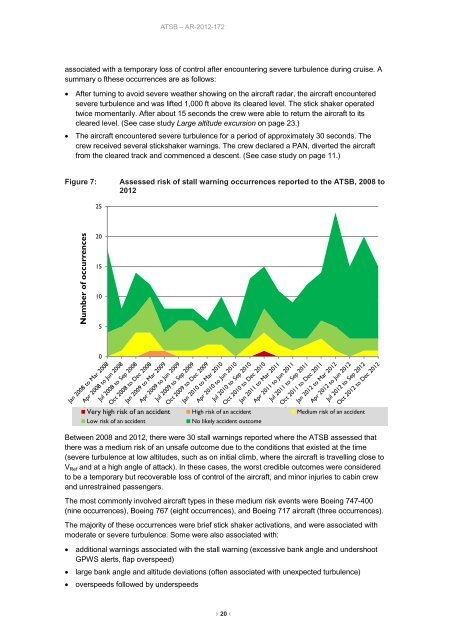Stall warnings in high capacity aircraft: The Australian context 2008 ...
Stall warnings in high capacity aircraft: The Australian context 2008 ...
Stall warnings in high capacity aircraft: The Australian context 2008 ...
You also want an ePaper? Increase the reach of your titles
YUMPU automatically turns print PDFs into web optimized ePapers that Google loves.
ATSB – AR-2012-172<br />
associated with a temporary loss of control after encounter<strong>in</strong>g severe turbulence dur<strong>in</strong>g cruise. A<br />
summary o fthese occurrences are as follows:<br />
• After turn<strong>in</strong>g to avoid severe weather show<strong>in</strong>g on the <strong>aircraft</strong> radar, the <strong>aircraft</strong> encountered<br />
severe turbulence and was lifted 1,000 ft above its cleared level. <strong>The</strong> stick shaker operated<br />
twice momentarily. After about 15 seconds the crew were able to return the <strong>aircraft</strong> to its<br />
cleared level. (See case study Large altitude excursion on page 23.)<br />
• <strong>The</strong> <strong>aircraft</strong> encountered severe turbulence for a period of approximately 30 seconds. <strong>The</strong><br />
crew received several stickshaker <strong>warn<strong>in</strong>gs</strong>. <strong>The</strong> crew declared a PAN, diverted the <strong>aircraft</strong><br />
from the cleared track and commenced a descent. (See case study on page 11.)<br />
Figure 7:<br />
Assessed risk of stall warn<strong>in</strong>g occurrences reported to the ATSB, <strong>2008</strong> to<br />
2012<br />
25<br />
Number of occurrences<br />
20<br />
15<br />
10<br />
5<br />
0<br />
Very <strong>high</strong> risk of an accident High risk of an accident Medium risk of an accident<br />
Low risk of an accident<br />
No likely accident outcome<br />
Between <strong>2008</strong> and 2012, there were 30 stall <strong>warn<strong>in</strong>gs</strong> reported where the ATSB assessed that<br />
there was a medium risk of an unsafe outcome due to the conditions that existed at the time<br />
(severe turbulence at low altitudes, such as on <strong>in</strong>itial climb, where the <strong>aircraft</strong> is travell<strong>in</strong>g close to<br />
V Ref and at a <strong>high</strong> angle of attack). In these cases, the worst credible outcomes were considered<br />
to be a temporary but recoverable loss of control of the <strong>aircraft</strong>, and m<strong>in</strong>or <strong>in</strong>juries to cab<strong>in</strong> crew<br />
and unrestra<strong>in</strong>ed passengers.<br />
<strong>The</strong> most commonly <strong>in</strong>volved <strong>aircraft</strong> types <strong>in</strong> these medium risk events were Boe<strong>in</strong>g 747-400<br />
(n<strong>in</strong>e occurrences), Boe<strong>in</strong>g 767 (eight occurrences), and Boe<strong>in</strong>g 717 <strong>aircraft</strong> (three occurrences).<br />
<strong>The</strong> majority of these occurrences were brief stick shaker activations, and were associated with<br />
moderate or severe turbulence. Some were also associated with:<br />
• additional <strong>warn<strong>in</strong>gs</strong> associated with the stall warn<strong>in</strong>g (excessive bank angle and undershoot<br />
GPWS alerts, flap overspeed)<br />
• large bank angle and altitude deviations (often associated with unexpected turbulence)<br />
• overspeeds followed by underspeeds<br />
› 20 ‹
















